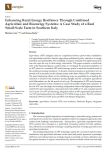Costa M., Barba S. (2025). Enhancing rural energy resilience through combined agrivoltaic and bioenergy systems: a case study of a real small-scale farm in Southern Italy. Energies, 01/10/2025, vol. 18, n. 19, p. 5139.
https://doi.org/10.3390/en18195139
https://doi.org/10.3390/en18195139
| Titre : | Enhancing rural energy resilience through combined agrivoltaic and bioenergy systems: a case study of a real small-scale farm in Southern Italy (2025) |
| Auteurs : | M. Costa ; S. Barba |
| Type de document : | Article |
| Dans : | Energies (vol. 18, n. 19, October 2025) |
| Article en page(s) : | p. 5139 |
| Langues : | Anglais |
| Langues du résumé : | Anglais |
| Catégories : |
Catégories principales 16 - TRANSPORT. INFRASTRUCTURE. ENERGIE ; 16.3 - EnergieThésaurus IAMM ENERGIE SOLAIRE ; BIOENERGIE ; RESILIENCE ; PETITE EXPLOITATION AGRICOLE ; ITALIE |
| Mots-clés: | AGRIVOLTAISME |
| Résumé : | Agrivoltaics (APV) mitigates land-use competition between photovoltaic installations and agricultural activities, thereby supporting multifaceted policy objectives in energy transition and sustainability. The availability of organic residuals from agrifood practices may also open the way to their energy valorization. This paper examines a small-scale farm in the Basilicata Region, southern Italy, to investigate the potential installation of an APV plant or a combined APV and bioenergy system to meet the electrical needs of the existing processing machinery. A dynamic numerical analysis is performed over an annual cycle to properly size the storage system under three distinct APV configurations. The panel shadowing effects on the underlying crops are quantified by evaluating the reduction in incident solar irradiance during daylight and the consequent agricultural yield differentials over the life period of each crop. The integration of APV and a biomass-powered cogenerator is then considered to explore the possible off-grid farm operation. In the sole APV case, the single-axis tracking configuration achieves the highest performance, with 45.83% self-consumption, a land equivalent ratio (LER) of 1.7, and a payback period of 2.77 years. For APV and bioenergy, integration with a 20 kW cogeneration unit achieves over 99% grid independence by utilizing a 97.57 kWh storage system. The CO2 emission reduction is 49.6% for APV alone and 100% with biomass integration. |
| Cote : | En ligne |
| URL / DOI : | https://doi.org/10.3390/en18195139 |







